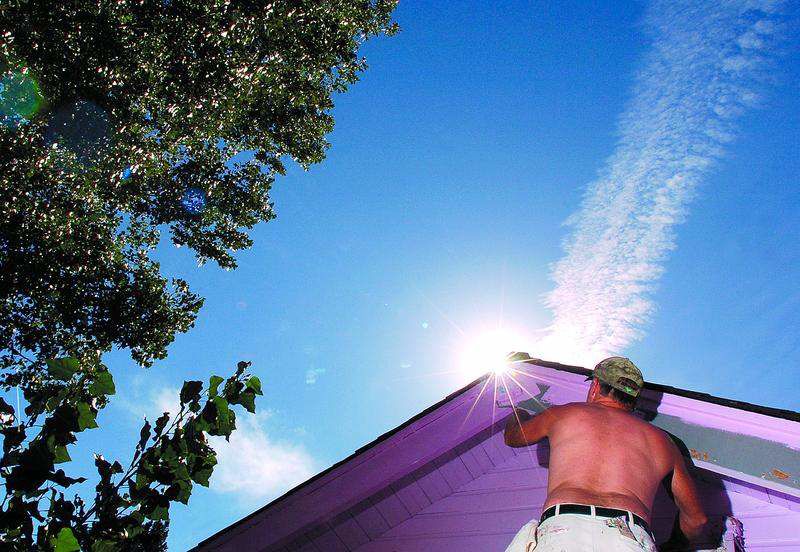Fall perfect time to winterize homes
Published 5:00 am Thursday, September 14, 2006

- Todd Kimmel, of Kimmel's Colors Painting, paints a house a bright shade of purple Wednesday afternoon in Bend. Residents are moving to complete projects that must be finished before winter weather sets in.
Fall may be another 10 days away, but temperatures this weekend may drop to the freezing mark, and industry experts say it’s not too early for homeowners to start preparing for Old Man Winter.
This week’s balmy weather will start to fade today, with cloudy skies moving in and high temperatures dropping to the upper 50s, said John Bonk, a meteorologist for the National Weather Service in Pendleton.
Trending
By early Saturday morning, Bonk said, the temperature will plummet to around 32 degrees and could leave the mountains dusted with snow.
That gives area residents the perfect chance to make sure their homes are well insulated, energy efficient and ready for colder weather.
”Mainly, if you can see your drapes moving, then you have some major air leaks, and that needs to be fixed,” said Mike Ryan, owner of Guarantee Glass and Mirror in Bend.
Among other things, Ryan’s company installs energy-efficient windows that can save his customers money year-round.
”The types of glass that can go in changes every year, but double-paned glass will block out heat in the summer and can also keep heat in during the winter,” he said.
Weather stripping around older windows is not nearly as effective as newer windows, he said.
Trending
And local utilities offer financing and rebate programs to help homeowners defray the cost of installation, said Jim Crowell, of Central Electric Cooperative.
The programs, also available from Pacific Power, offer rebates and tax credits for energy-efficient appliances, windows and insulation upgrades, Crowell said.
New homeowners can rely on the inspection process to catch any insulation problems, said Bob Ritchey, production manager for Comfort Insulation and Specialties in Bend. But older insulation can settle, compromising its effectiveness.
Ritchey recommends that homeowners check floor and ceiling insulation in homes built before the early 1980s.
”If the home was built in the ’70s or early ’80s, then it may not be up to code,” he said. ”You really don’t need to replace any existing insulation; typically you would add to it.”
An insulation level of 15 inches is a good rule of thumb, he said, depending upon the type installed in the home.
He recommended checking insulation levels every 12 to 15 years.
Plumbing also can benefit from proper insulation in the winter, said John Woolery, owner of Deschutes Plumbing in Bend.
Pipes in most newer homes are strategically placed for warmth, Woolery said, but exposed pipes in any home should be insulated before the snow falls.
When the weather turns cold, he said, homeowners should also be sure to close foundation vents, designed to keep air circulating through the house.
Adding insulation designed to fit in the vents will keep plumbing running underneath a home much warmer, decreasing the chance that a pipe will freeze or burst.
Also, keeping the faucet on drip during extremely cold temperatures really does help prevent freezing, Woolery said, particularly if it is hot water.
”The hot water pipe will freeze before the cold water,” he said. ”Ninety percent of the pipes you go in and fix are going to be hot water.”
The phenomenon of hot water freezing faster than cold is known as the Mpemba effect, according to Physicsweb.org, and has been proven in repeated scientific experiments.
Snowbirds, who cannot leave their water dripping all winter, should take other steps to avoid returning to potentially costly water damage in the spring.
”First, shut the water off,” Woolery said. ”Drain the water from the pipes or have someone come in and blow them out with air.
”Also, there is water in your toilets and your showers,” he continued. ”You can pour a little RV antifreeze in there to keep them from freezing.”
During last winter’s cold snap, he said, it was common for toilets to crack and break apart after freezing.
On the exterior of the home, Woolery said he commonly encounters frozen hose bibs, or outdoor spigots.
”People leave their hose on their hose bib and it doesn’t have a chance to drain out and it freezes,” he said. ”It can’t drain out if the hose is on it.”
Water lines to outside irrigation pipes also should be shut off, Woolery said. Like interior pipes, blowing air through irrigation systems is the best way to avoid a freeze.
While working outside in the fall, residents should turn their heads skyward and check out the condition of their gutters, said Jean Marriner, owner of Gutterman in Bend.
”Probably the first thing is to make sure they are clean going into winter because if you have debris that will freeze they can clog up,” she said.
Choosing the perfect time for gutter cleaning can be a cat-and-mouse game with trees that can shed their leaves as early as September and as late as December, she said.
”It’s best to wait until the leaves fall, especially if you have trees that are really close to the house,” Marriner said. ”But sometimes the snow will fall and the leaves haven’t fallen yet, so you should probably clean them out while the weather is still nice.”
Sagging gutters should be tightened up, she said, and leaky gutters need replacement.
”If they are tight and draining well then they shouldn’t need to be replaced unless they are worn and beat up because of re-roofing or ladder damage,” she said.
Newer homes sometimes settle, she said, affecting water flow and efficiency.
”Look at them periodically to see if there is an accumulation of water that isn’t moving because that can freeze up during the winter,” Marriner said.
And if they do need to be replaced, early fall is the perfect time.
”It’s better to replace them now or you’ll probably want to wait until the beginning of summer,” Marriner said.
for more info
* Information about energy efficiency programs in Oregon with cash incentives for new and existing homes can be found at www.energytrust.or.
* Information about tax credits for energy efficient homes can be found out at http://egov.oregon.gov /ENERGY/CONS/RES /RETC.shtm








